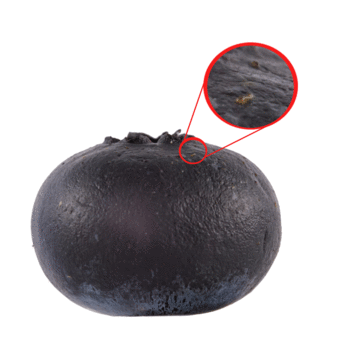The call of the dung
Frass excreted on fruits by vinegar flies contains sex pheromones and invites conspecifics to join the meal
Like many other insects, vinegar flies produce pheromones to call their conspecifics to an interesting food source. A research team of the Max Planck Institute for Chemical Ecology in Jena, Germany, demonstrated in a new study that the flies’ frass also contains these pheromones. Fruits that have been covered by the insects’ fecal excretions seem to be especially attractive to other flies. These fruits are probably a more easily digestible food after many flies have been feeding on them. The new results are a first step toward understanding the importance of feces in the communication of vinegar flies.

Vinegar flies (Drosophila melanogaster) are able to locate a food source by smelling the odor of overripe fruit. Fruits not only serve the uptake of nutrients, they are also ideal locations for finding a sexual mate and for laying eggs after mating. In previous studies, researchers had noticed that sites that had been visited by many adult flies were especially attractive to their conspecifics. However, the reasons behind this behavior were unclear.
Behavioral assays provided an unambiguous result: The insects are attracted to the smell of their conspecifics’ feces. “Even though it is known that some beetle species use their fecal excretions to pass information to their conspecifics, we were surprised about how highly attractive even the smallest amounts of frass were to vinegar flies,” reports Ian Keesey, the first author of the study.
The researchers conducted behavioral experiments with traps which contained different odors and were able to quantify the attractiveness of an odor by counting the flies in the traps. On top of that, they applied the flywalk, an analytic device that measures whether an odor is attractive or repellent by recording the behavior of single flies in a glass tube filled with different odors. If a fly moves upwind, towards the odor source, the odor is rated as attractive. If a fly moves downwind, away from the odor source, the odor is rated a deterrent. Interestingly, when fecal odors were tested, the flies always moved towards the source.
Frass contains pheromones
The next step was to chemically analyze the frass to find out which odor components of the flies’ feces were appetizing. To the scientists’ surprise, the frass contained sexual pheromones. The frass odors are not only species-specific, they are also different in males and females. If many flies visit a fruit, they also lay more eggs on it. Larvae hatching from these eggs might benefit from the presence of the larvae that were there previously: They could process the food more easily when it has been “pre-digested” by microorganisms in the frass of their conspecifics. The presence of frass not only attracts more flies, the flies also eat and excrete more, and this raises the attractiveness of a food source further.
“Frass seems to be an important communication tool between individuals of one species. Surprisingly, it has been neglected in many ecological studies so far,” explains Markus Knaden from the Department of Evolutionary Neuroethology and head of the study. “Talking about bodily excretions is still a kind of taboo and this may have contributed to the fact that researchers avoided this topic in the past. This is even more astonishing in the case of Drosophila melanogaster, considering the many other ecological aspects that have been studied intensively in this insect.”
Means for pest control?
Future studies will be extended to related fly species. These studies will include Drosophila suzukii. Unlike its relative Drosophila melanogaster, which is attracted to overripe and rotting fruit, the suzukii fly attacks fresh or ripening berries and grapes and is a, hard-to-control pest in orchards and vineyards. If this species is as attracted to its own frass in a similar way as Drosophila melanogaster is, new possibilities to effectively control this pest would open up.
KG/AO/HR












